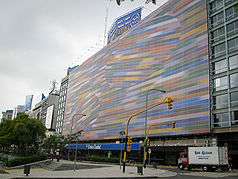Bank of the City of Buenos Aires
 | |
| State enterprise | |
| Founded | 1878 |
| Headquarters | Buenos Aires, Argentina |
Key people | Rogelio Frigerio, President |
| Products |
Retail Banking Business finance Trade finance Factoring Mutual funds Pension funds Insurance Mortgages Consumer Finance Credit cards |
| Revenue |
|
|
| |
| Total assets |
|
Number of employees | 3,150 (2/2010)[2] |
| Website | www.bancociudad.com.ar |
The Bank of the City of Buenos Aires (Banco Ciudad de Buenos Aires) is a publicly owned, municipal commercial bank in Buenos Aires, Argentina.
Overview
.jpg)
The bank was chartered on May 23, 1878, as the Monte de Piedad (Piety Mount) in a measure against the prevalence of usury in Buenos Aires (mostly targeting the growing wave of immigration in Argentina).[3] The board of directors' first meeting on July 10 outlined the goal of "serving the working community, which is in the greatest need of such an institution." Opening its doors in a Montserrat ward residence formerly belonging to Viceroy Joaquín del Pino (1801–04), the bank grew quickly; in 1888, it was nationalized and transferred to the City of Buenos Aires.
Its new headquarters in the financial district was accompanied by new market capitalization, allowing it provide personal, business and mortgage loans and payday advances. It soon began to administer pension funds and became a leading local source for underwriting of initial public offering activity on the Buenos Aires Stock Exchange, government bonds, and foreign trade, as well. The institution was rechartered officially as the Municipal Savings and Loan Bank in 1904.[3]
Following initially disappointing results, increased investment in bank branches, agencies and other forms of representation led to the institution's renewed growth, particularly during the tenure of bank president Enrique Peña, who in 1916 committed the institution to "combat usury in the most effective possible way - making branches readily available throughout the city so as to lessen inconvenience to those who need our services." [3]
A nationalist coup in 1943 led to the sudden advent of Col. Juan Perón as the new regime's chief policy-maker. The new government quickly made the control of price gouging in banking and public services a policy centerpiece,[4] and in 1944, the savings & loan was again re-chartered as the Municipal Bank of Buenos Aires to give depositors more commercial banking options in Argentina's growing public sector.[3]
The bank became a leader in small business lending, and financed public housing projects in underprivileged areas. The city purchased a downtown lot on the massive Nueve de Julio Avenue (where the Mercado del Plata wholesaler stood) in 1947 for the construction of municipal offices, and an important branch was opened therein after the building's 1961 completion. The bank's headquarters were relocated to a refurbished Florida Street building, the former A la Ciudad de México department store, in 1968. These and other new offices allowed the bank to expand its larger-scale commercial lending activities. Its growing competition with the Bank of the Province of Buenos Aires led to the adoption of its current name in 1972.[3]

The Bank of the City of Buenos Aires is the ninth-largest in Argentina by deposits, which in February 2010 totaled US$3.6 billion (3.6% of the domestic total), and its loan portfolio of US$2.8 billion made it the nation's eighth-largest lender; it maintained 61 branches, employing over 3,000 people.[2]
A new headquarters was commissioned to British architect Lord Norman Foster in 2010 for its construction in the Parque Patricios neighborhood. The 35,000 m² (380,000 ft²) headquarters will become only the second building in Argentina, and the first public sector building in Latin America, to earn the LEED Silver Certification for sustainable architecture.[5]
References
- 1 2 "Estados Contables" (PDF). Banco Ciudad.
- 1 2 3 "Ranking del Sistema Financiero". ABA.
- 1 2 3 4 5 Banco Ciudad: historia (Spanish)
- ↑ Lewis, Paul. The Crisis of Argentine Capitalism. University of North Carolina Press, 1990.
- ↑ "Avances de la construcción del Banco Ciudad". Clarín.
External links
Coordinates: 34°36′15.5″S 58°22′31″W / 34.604306°S 58.37528°W